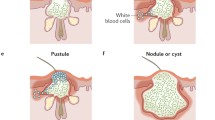Abstract
Background
Although acne is almost universal in teenagers, few large cohort studies have investigated the profile of acne patients.
Objectives
To identify the profile of European patients with mild-to-moderate acne.
Materials and methods
An epidemiological study was performed using inclusion data from a prospective, international, observational phase IV study conducted in patients prescribed an anti-acne cream containing retinaldehyde, glycolic acid, modified rhamnose and Avene Thermal SpringWater.
Results
Atotal of 2926 patients (73.1% female) with mild to moderate acne (mean Global Evaluation of Acne score of 2.55 ± 0.7), aged 22.5 ± 8.0 years, were included in France, Switzerland, Italy and Portugal. A family history of acne was present in 62.9% of patients and mean age at acne onset was 16.0 ± 4.9 years. In total, 69.6% of patients had moderate to severe hyperseborrhoea, 35.6% acne lesions on both face and trunk, 23.6% facial pigmentation and 46% scars. The extent of acne was significantly associated with sex, age at acne onset, history of acne and presence of scars. In women, acne onset was delayed (p<0.0001) and a family history of acne and extension to the trunk were less common than in men (p = 0.0118, and p<0.0001), as were scars (p = 0.0042). In subjects with a family history of acne, the frequency in men was higher (p = 0.0118), acne onset was earlier (p<0.0001) and extension to the trunk and presence of scars were more common (both p<0.0001).
Conclusion
Further epidemiological studies would help define specific risk factors for acne occurrence or progression, which may be modified.
Similar content being viewed by others
References
Dréno B, Poli F. Epidemiology of acne. Dermatology 2003; 206: 7–10.
Collier CN, Harper JC, Cafardi JA, et al. The prevalence of acne in adults 20 years and older. J Am Acad Dermatol 2008; 58: 56–9.
Ghodsi SZ, Orawa H, Zouboulis CC. Prevalence, severity, and severity risk factors of acne in high school pupils: a community-based study. J Invest Dermatol 2009; 129: 2136–41.
Stathakis V, Kilkenny M, Marks R. Descriptive epidemiology of acne vulgaris in the community. Australas J Dermatol 1997; 38: 115–23.
Friedlander SF, Eichenfield LF, Fowler JF Jr., Fried RG, Levy ML, Webster GF. Acne epidemiology and pathophysiology. Semin Cutan Med Surg 2010; 29: 2–4.
Williams HC, Dellavalle RP, Garner S. Acne vulgaris. Lancet 2012; 379: 361–72.
Layton AM, Henderson CA, Cunliffe WJ. A clinical evaluation of acne scarring and its incidence. Clin Exp Dermatol 1994; 19: 303–8.
Barratt H, Hamilton F, Car J, Lyons C, Layton A, Majeed A. Outcome measures in acne vulgaris: systematic review. Br J Dermatol 2009; 160: 132–6.
Eichenfield LF, Krakowski AC, Piggott C, et al. Evidence-based recommendations for the diagnosis and treatment of pediatric acne. Pediatrics 2013; 131: S163–86.
Bhate K, Williams HC. Epidemiology of acne vulgaris. Br J Dermatol 2013; 168: 474–85.
Thiboutot D, Gollnick H, Bettoli V, et al. Global Alliance to Improve Outcomes in Acne. New insights into the management of acne: an update from the Global Alliance to Improve Outcomes in Acne group. J Am Acad Dermatol 2009; 60: S1–50.
Dréno B, Poli F, Pawin H, et al. Development and evaluation of a Global Acne Severity Scale (GEA Scale) suitable for France and Europe. J Eur Acad Dermatol Venereol 2011; 25: 43–8.
Dreno B, Khammari A, Orain N, et al. ECCA Grading Scale: An Original Validated Acne Scar Grading Scale for Clinical Practice in Dermatology. Dermatology 2007; 214: 46–51.
Motley RJ, Finlay AY. Practical use of a disability index in the routine management of acne. Clin Exp Dermatol 1992; 17: 1–3.
Dreno B, Finlay AY, Nocera T, Verrière F, Taïeb C, Myon E. The Cardiff Acne Disability Index: cultural and linguistic validation in French. Dermatology 2004; 208: 104–8.
Wei B, Pang Y, Qu L, et al. The epidemiology of adolescent acne in North East China. Journal of the European Academy of Dermatology & Venereology 2010; 24: 953–7.
Melnik BC, Schmitz G. Role of insulin, insulin-like growth factor-1, hyperglycaemic food and milk consumption in the pathogenesis of acne vulgaris. Exp Dermatol 2009; 18: 833–41.
Zaraa I, Belghith I, Ben Alaya N, Trojjet S, Mokni M, Ben Osman A. Severity of acne and its impact on quality of life. Skinmed 2013; 11: 148–53.
Layton AM. Optimal management of acne to prevent scarring and psychological sequelae. Am J Clin Dermatol 2001; 2: 135–41.
Hayashi N, Miyachi Y, Kawashima M. Prevalence of scars and “mini-scars”, and their impact on quality of life in Japanese patients with acne. J Dermatol 2015; 42: 690–6.
Author information
Authors and Affiliations
Corresponding author
About this article
Cite this article
Dréno, B., Jean-Decoster, C. & Georgescu, V. Profile of patients with mild-to-moderate acne in Europe: a survey. Eur J Dermatol 26, 177–184 (2016). https://doi.org/10.1684/ejd.2015.2722
Accepted:
Published:
Issue Date:
DOI: https://doi.org/10.1684/ejd.2015.2722




